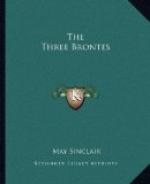She was only twenty-four. Even as late as the mid-Victorian era to be twenty-four and unmarried was to be middle-aged. But (this cannot be too much insisted on) Charlotte Bronte was the revolutionist who changed all that. She changed it not only in her novels but in her person. Here again she has been misrepresented. There are no words severe enough for Mrs. Oliphant’s horrible portrait of her as a plain-faced, lachrymose, middle-aged spinster, dying, visibly, to be married, obsessed for ever with that idea, for ever whining over the frustration of her sex. What Mrs. Oliphant, “the married woman”, resented in Charlotte Bronte, over and above her fame, was Charlotte’s unsanctioned knowledge of the mysteries, her intrusion into the veiled places, her unbaring of the virgin heart. That her genius was chiefly concerned in it does not seem to have occurred to Mrs. Oliphant, any more than it occurred to her to notice the impression that Charlotte Bronte made on her male contemporaries. It is doubtful if one of them thought of her as Mrs. Oliphant would have us think. They gave her the tender, deferent affection they would have given to a charming child. Even the very curates saw in her, to their amazement, the spirit of undying youth. Small as a child, and fragile, with soft hair and flaming eyes, and always the pathetic, appealing plainness of a plain child, with her child’s audacity and shyness, her sudden, absurd sallies and retreats, she had a charm made the more piquant by her assumption of austerity. George Henry Lewes was gross and flippant, and he could not see it; Branwell’s friend, Mr. Grundy, was Branwell’s friend, and he missed it. Mrs. Oliphant ranges herself with Mr. Grundy and George Henry Lewes.
But Charlotte’s fun was soon over, and she became a nursery-governess again at Mrs. White’s, of Rawdon. Anne was with Mrs. Robinson, at Thorp Green.
Emily was at Haworth, alone.
That was in eighteen-forty-one. Years after their death a little black box was found, containing four tiny scraps of paper, undiscovered by Charlotte when she burnt every line left by Anne and Emily except their poems. Two of these four papers were written by Emily, and two by Anne; each sister keeping for the other a record of four years. They begin in eighteen-forty-one. Emily was then twenty-four and Anne a year and a half younger. Nothing can be more childlike, more naive. Emily heads her diary:
A PAPER to be opened
when Anne is
25 years old,
or my next birthday after
if
all be well.
Emily Jane Bronte. July the 30th, 1841.
She says: “It is Friday evening, near nine o’clock—wild rainy weather. I am seated in the dining-room, having just concluded tidying our desk-boxes, writing this document. Papa is in the parlour—Aunt upstairs in her room.... Victoria and Adelaide are ensconced in the peat-house. Keeper is in the kitchen—Hero in his cage.”
Having accounted for Victoria and Adelaide, the tame geese, Keeper, the dog, and Hero, the hawk, she notes the whereabouts of Charlotte, Branwell, and Anne. And then (with gravity):




